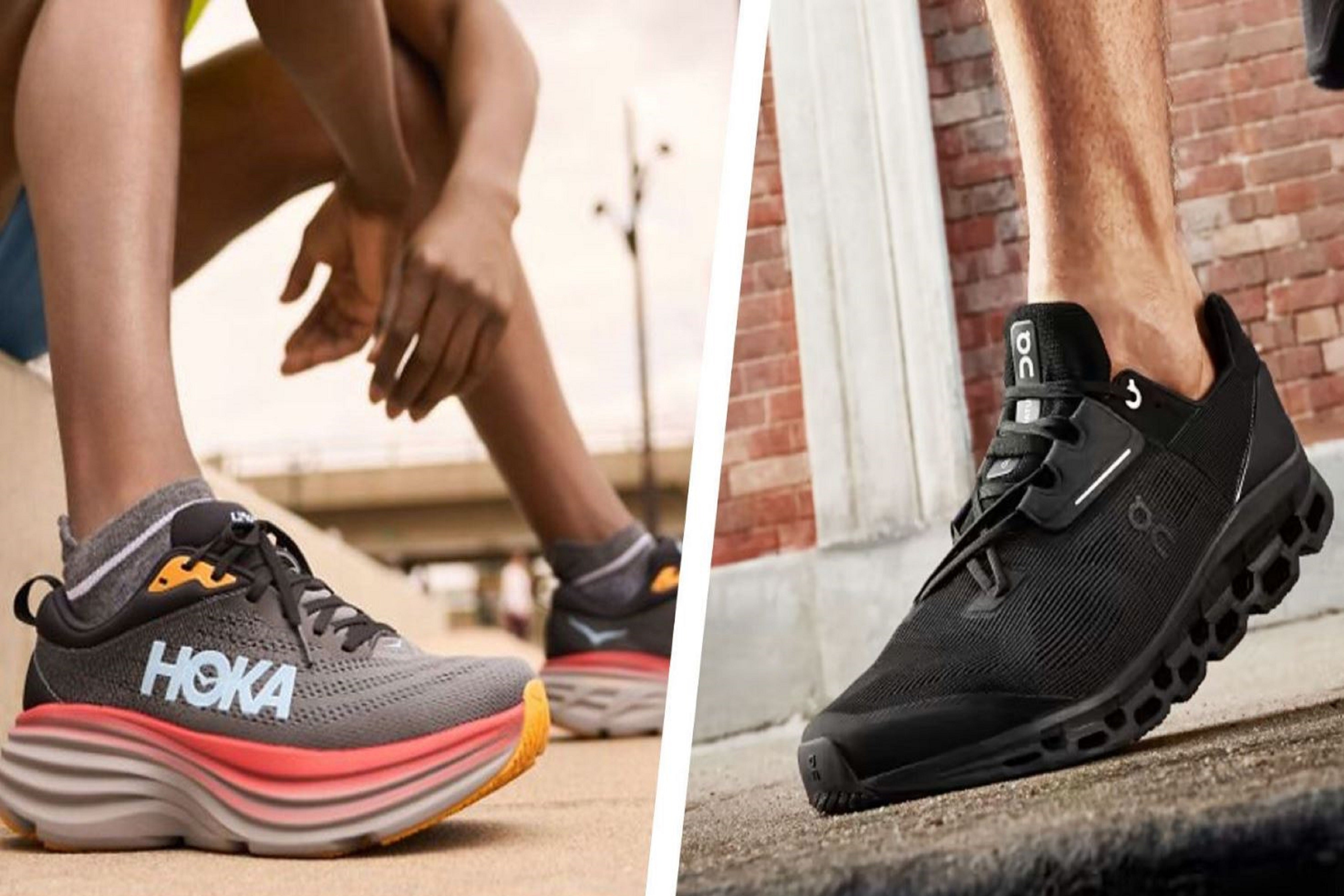On Running and Hoka are two of the most popular and recognizable running shoe brands today. Hoka One One was founded in 2009 in France by Nicolas Mermoud and Jean-Luc Diard, with the goal of creating shoes that would help them run faster downhill. The name "Hoka" comes from the Maori language phrase "fly over the earth”. On Running, on the other hand, was founded a year later in 2010 in Switzerland by a team of athletes and sports scientists.
Both offer unique and innovative technologies and serve similar purposes but also differ in functionality due to their distinct approaches to cushioning, stability, and fit. Let’s find out how.
Hoka and On Running: Key Differences
Proprietary Technologies
On Running is known for its revolutionary CloudTec® sole, which features a series of cloud-like pods made from a proprietary foam called Helion. These pods compress to absorb shock and then rebound to provide a responsive and cushioned ride. The CloudTec® system is designed to mimic the natural movement of the foot, offering a smooth and efficient stride. Additionally, On Running uses Speedboard technology, which is a thin, flexible plate that runs the length of the midsole to provide a responsive and propulsive feel.
In contrast, Hoka takes a maximalist approach. Their shoes feature oversized midsoles made from a lightweight, resilient foam called CMEVA (Compression Molded EVA). This generous cushioning is intended to provide exceptional shock absorption and a comfortable feel, especially for those who do long-distance runs or trails. Hoka also incorporates Meta-Rocker design, which is a subtle curve in the midsole and outsole that encourages a smooth, rocking-chair-like transition from heel strike to toe-off.
Performance

When it comes to performance, the differences in technology translate to distinct experiences.
On Running shoes tend to offer a more responsive and nimbler feel, allowing for a natural and efficient running gait. The CloudTec® pods and Speedboard work together to provide a snappy, energetic ride that is well-suited for speed work, tempo runs, and races.
Hoka, on the other hand, excels in providing a soft and forgiving ride, particularly for those seeking maximum impact protection. The oversized midsole and Meta-Rocker design create a smooth, cushioned feel that is ideal for long-distance runs and recovery days.
Cushioning & Weight
When it comes to running shoes, cushioning and weight are two crucial factors that can make or break your running experience. On Running and Hoka takes different approaches to these elements, each with its own unique benefits.
On Running shoes are designed with a lightweight construction. On average, a standard On Running shoe weighs around 9.5 oz (269g). This featherlight feel is achieved through their innovative CloudTec® technology. The CloudTec® technology is engineered to mimic the natural movement of your foot, offering a smooth and efficient stride. This makes On Running shoes perfect for speed work, tempo runs, and races, where a lightweight and agile feel can give you an extra edge.
Hoka, on the other hand, takes a maximalist approach to cushioning. Their shoes feature a significantly higher stack height and a thicker, plusher midsole. On average, a standard Hoka shoe weighs around 9.8 oz (278g), slightly heavier than On Running shoes but still impressively lightweight considering the amount of cushioning provided. This generous cushioning is designed to provide exceptional impact protection and a soft, comfortable ride. It's perfect for those tackling long-distance runs or trails, where your feet need that extra layer of comfort and support.
Stability
On Running takes a more minimalist approach to stability. Their shoes rely on the natural stability provided by the CloudTec® technology. This clever system features cloud-like pods that compress to absorb the shock and then bounce back. This responsive cushioning works together with your foot's natural movement, giving you a secure and confident feel without any bulky stability features.
Hoka on the other hand, offers a more substantial and supportive platform. Their shoes have oversized midsoles and a wider base, creating a stable and guiding ride. This extra support can be really helpful for runners who need a little more stability, like those with certain foot conditions or who tackle long runs on varied terrain. Additionally, some Hoka models incorporate their J-Frame™ technology, which is a reinforced medial post that provides extra stability and support.
Durability
On Running's innovative CloudTec® technology is designed to provide a responsive and cushioned ride for many miles. However, the durability can differ depending on the specific model and materials used. For example, their Cloudflash model, which is optimized for speed work, may not last as long as their everyday training shoes. They generally recommend replacing their shoes every 300-500 miles (500-800 km) of use, or every 3-6 months, depending on your training and body factors.
Hoka on the flip side is known for their maximalist cushioning and durable construction. Like On Running, Hoka also suggests replacing their shoes after 300-500 miles (500-800 km) of use, or every 3-6 months for regular runners. The generous cushioning and reinforced materials used in Hoka shoes may contribute to their perceived longevity.
While the shoes themselves play a big role in how long they'll last, there are also a bunch of personal factors that can impact the lifespan of your running shoes. Things like your body weight, running style, how often you switch between different pairs - that all makes a difference in how quickly your shoes wear down.
Affordability
On Running shoes are generally priced on the more accessible end of the spectrum. Their shoes typically range from around $130 to $200 USD. This relatively affordable pricing is a result of their streamlined and lightweight construction, which utilizes innovative materials and technologies like the CloudTec® system.
In comparison, Hoka One One shoes tend to be priced slightly higher, typically ranging from $140 to $250 USD. This slightly higher price point reflects the brand's maximalist approach to cushioning and support. The thicker, more plush midsoles and reinforced materials used in Hoka shoes contribute to their premium pricing.
Hoka & On Running Shoe Fit
Both brands prioritize a comfortable fit, but their approaches differ slightly. On Running shoes often feature a snugger fit, providing a sock-like feel that hugs the foot securely. This design promotes stability and responsiveness, ideal for runners who prefer a locked-in sensation. Conversely, Hoka shoes tend to offer a roomier toe box and a more generous fit overall, accommodating a wider range of foot shapes and sizes.
Sustainability
On Running takes a proactive approach to sustainability. They use recycled polyester in the upper fabrics of many of their shoe models, reducing the reliance on virgin plastics. Additionally, On Running has a "Cycle" program that allows customers to return their worn-out shoes, which are then recycled or repurposed into new products. This closed-loop system helps to minimize waste and promote a more circular economy.
Hoka also recognizes the importance of sustainability and has begun to integrate eco-friendly practices into their product development. Some Hoka models feature midsoles made from a bio-based foam, which reduces the use of petroleum-derived materials. The brand has also partnered with organizations like Protect Our Winters to support initiatives that address climate change and environmental conservation.
Both On Running and Hoka excel in their respective niches within the running shoe market. On Running shines with its lightweight construction and responsive CloudTec technology, appealing to speed-oriented runners seeking a dynamic ride experience. Meanwhile, Hoka’s maximalist cushioning offers unparalleled comfort and support, making it a top choice for endurance runners tackling long distances.
Ultimately, the decision between these two brands comes down to personal preferences, running style, and budget considerations. Whichever brand you choose, rest assured that both On Running and Hoka One One are committed to helping you achieve your running goals with their innovative footwear designs.



